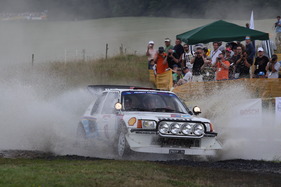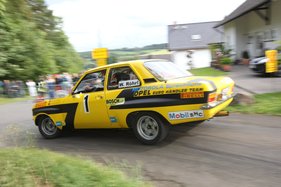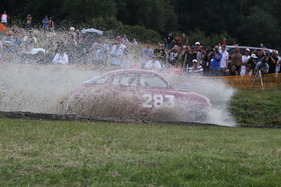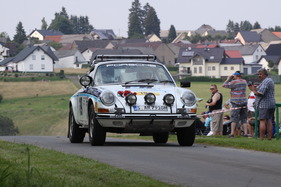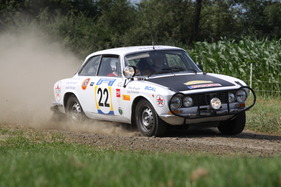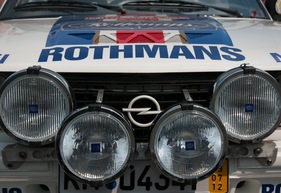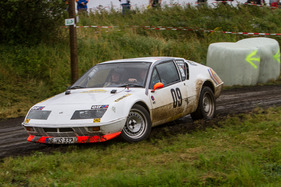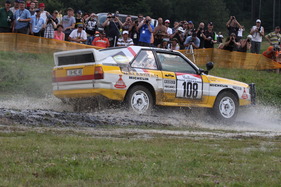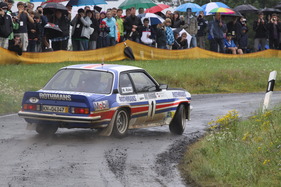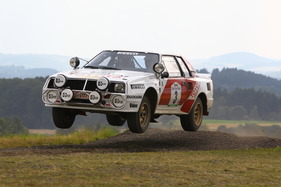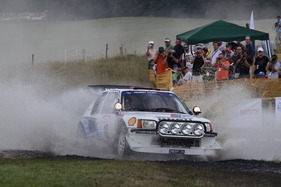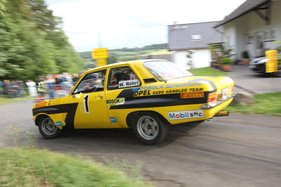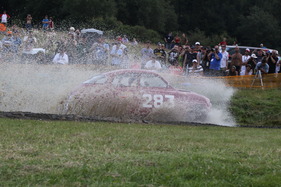The Eifel Rallye Festival (ERF) is a summit meeting of highly decorated drift stars from earlier days on board high-quality driving equipment. A drifting museum of Ascona, Quattro, Delta, 911 and Escort. It roars, it dusts, it boils, with 150 historic rally cars and 40,000 spectators.
Sometimes, if someone puts in a good word for you, it gets even better, and you get to take part in the fun of tilling the field yourself. As the co-driver of a rally legend.
"Nothing bad." Walter Röhrl comments briefly and dryly on my comment that I have zero racing experience and don't know what to expect on a lap with him, the two-time rally world champion. You're allowed to express so many concerns as AR political editor. But "nothing bad" has to suffice as reassurance, the 65-year-old Bavarian is no chatterbox.
Shortly before, I was still completely calm. The Opel Ascona 400 is not a very intimidating car by nature. In shape, it's more of a bourgeois than a firebrand. At least the Rothmans decor adds a bit of zest to the shell.
Röhrl's many car changes
Inside, the unfurnished emptiness of a racing machine. A few buttons and switches without labels. Röhrl has to think for a moment, after all, he is constantly changing cars at the ERF: from the Ascona 400 to a Porsche 911 SC, then to the powerful Audi Sport Quattro E2 Group B car, and in between times to the Opel Ascona A.
Walter Röhrl may have retired from professional racing in 1987, but he still drives fast, not least as a set-up driver for Porsche. Röhrl is the patron of the event in the Eifel, which will be held for the second and probably not the last time in 2012. He is the undisputed star, although by no means the only one. And his long-time co-driver Christian Geistdörfer is a co-organizer (see interview). But the autograph hunters, and there are plenty of them in the Eifel town of Daun these days, are after Röhrl.
Now it's out onto the track for the "shakedown" on the day before the actual two-day festival. The 2.4-liter in-line four-cylinder engine of the restored Ascona roars and screams rudely, but not infernally loud. The spectators, or rather listeners, like the Ascona music: another Ascona 400 wins the trophy for the best sound in a text message vote. The racing machine from the 1980s is also rough to operate. You can feel the effort that Röhrl has to put into steering, shifting and braking maneuvers.
Like most of the special stages over the next two days, it is a lively ride through the rolling hills of the Volcanic Eifel. On narrow roads and country lanes, between hedges, in hairpin bends the rear wheel brake makes the rear end light, over crests the whole load light thanks to the speed. There is nothing left of the Ascona's well-behaved exterior, and a good 250 hp is not at all comfortable on the winding terrain. Nevertheless, the sovereignty of the old master at the wheel never gives rise to the slightest concern. But one question mark remains: How on earth do the co-drivers manage to follow the road book exactly at this speed?
Without time pressure
Almost everyone involved in the ERF drives fast, but not for time. The special stages are not timed either; the festival is designed solely as fun for participants and spectators - of which, according to the organization, there were around 40,000 over the three days. The vehicle owners and amateur drivers appreciate this just as much as the stars. Harald Demuth, two-time German rally champion: "You can drive here without any pressure. If you want, you can have fun in the cockpit and with the spectators or just relax. Where else can you do that?"
The basic idea of the Slowly Sideways interest group, which is behind the event in the Eifel, is to let people drive instead of just displaying them in a museum. To encourage owners to hand over their rare parts (or drive them themselves), the routes are laid out with a lot of asphalt or, as was the case this year in the "Bosch Super Stage", which runs over loose ground, alternative routes are built in at critical points. This meant that nobody had to ride the material-killing jump hill or the water hole. Most of the "swervers" compensated the spectators with a hearty drift around the obstacle.
Homage to the Safari Rally
The "Super Stage" was perfect for those vehicles that started in Safari Rallye trim. "Safari Rally" was the special theme of this year's ERF, with a corresponding route on the one hand and a video evening on the big screen on the "Rally Mile" in the small town of Daun with impressive images by filmmaker Helmut Deimel on the other. Ten years ago, the tough endurance stage in East Africa was on the World Rally Championship calendar for the last time.
A number of celebrities with special connections to the legendary Africa Rally met at the rally festival in the Eifel. In addition to Röhrl, who was never able to win there, for example, Yvonne Mehta, widow of the five-time (record) winner Shekhar, who was his co-driver for many years, although not at the Safari Rally. In the Eifel, she once again acted as the woman for the "prayer book", this time for a British Subaru driver.
Even more prominent was Björn Waldegård, who won the Safari Rally three times. Away from the car and the race track, the 68-year-old looks like a cliché Swede, walking and talking rather deliberately. But once behind the wheel, the veteran undergoes a transformation, and there is no longer any question of him being cautious. Waldegård sped around the corners in a safari car (Porsche 911 2.7 RS) without taking any particular care of the material, while his compatriot and former world champion Stig Blomqvist, for example, handled a "normal" rally racer, the Group B Ford RS200, with obvious care. Apparently there were also technical problems with the freshly restored Ford.
"Surviving the "Manta hole
In the category of well-known names, there was also a rally debut in the Eifel: touring car driver Joachim Winkelhock accepted an invitation from event main sponsor Opel and stepped on the gas behind the wheel of an Ascona A. He showed off his skills with clean drifts, for example at the infamous "Manta hole". Jockel" acknowledges the question about the fun with the corners of his mouth from ear to ear
During the AR writer's test drive with Walter Röhrl, "nothing bad" happened, as he had announced. He wants it to stay that way until he puts his racing helmet away for good. You can hear that he is thinking about it in many of his statements. But in 2013, that much seems certain, the ERF organizers of "Slowly Sideways" can once again count on their patron.
Interview with Christian Geistdörfer
Christian Geistdörfer is involved in the organization of the Eifel Rallye Festival (ERF) and uses his network of contacts to ensure that great cars and the stars of yesteryear find their way to western Germany. Geistdörfer was twice world champion as Walter Röhrl's co-driver. Geistdörfer earns his living as a consultant in the automotive sector for events, in sports sponsoring for motorsport and in consulting for marketing strategies for new F1 race tracks. The 59-year-old has also been a brand ambassador for Opel since 2010.
A starting field of around 150 cars. Does this mean a full house, i.e. complete success, or would more be possible?
We deliberately decided on this size when designing the event. It would easily be possible to run with 250 vehicles. We had to turn down entries again this year because we have high demands on the quality standard of the vehicles. We want to have original vehicles at the start or at least replicas that are as close to the original as possible. There has never been a rally Audi Quattro with a sliding roof, which is why we don't have one in the main field.
Are there actually many nice starting opportunities for rally cars?
Apart from the "Rally Legend" event in San Marino, there is no comparable event in Europe, as we only organize these for historic rally cars. Of course, it often happens that small numbers of historic vehicles can be seen as "break fillers" at normal rallies.
The former top drivers choose the best organizers and come if a suitable vehicle is provided.
Almost all participants seem relaxed and easy-going. After all, it's not a race...
The Eifel Rallye Festival is a show event where the focus is on having fun. Everyone should drive the historic vehicles to the best of their ability. Timekeeping would unnecessarily increase the pressure, and some would not show their "darlings". Besides, how can I compare a 1958 Wartburg with a 1985 Audi Quattro? There is no equation, no matter how complicated, that could do that. So everyone drives as best they can, and some really step on the gas, not just the former world champions. The audience likes it, and that's the most important thing.
This year, the race was dedicated to the Safari Rally. Why?
We came up with the theme because the last Safari Rally was held exactly ten years ago as part of the World Rally Championship. So it was a kind of obituary for the toughest rally on the calendar, which is now still run with historic vehicles.
Are you also nostalgic for the days when something as crazy as this rally was still possible?
Of course. The World Rally Championship in the old format (at least 2500 km/1000 km special stage, day and night driving over 24 hours in all weather conditions, off-road service under high time pressure), that was a completely different spirit. Not only at the Safari. I think the rally in the new format lacks passion, closeness and drama.
Central service parks that keep the fans at a distance and drivers who only wave from a distance no longer allow the original fascination of the rally to be experienced. It's a shame really, as we now see sons who only know the old days from videos and still travel enthusiastically to the rally festival with their fathers. We are doing something right!
So you take a critical view of rallying in its current form.
The sport has lost a lot of ground. Central marketing has failed. The FIA has not covered itself in glory. The sport is at a crossroads, although great things could have been achieved with VW's involvement. Unfortunately, there is no integration figure who could finally coordinate all those involved. But perhaps that is intentional.






